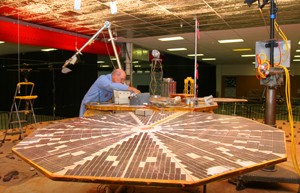Scientists working on the Phoenix Mars Mission at the UA kept busy this summer, and thanks to recent discoveries, they will be staying busy for at least another month.
The UA-led Phoenix Mars Mission began in May when the Phoenix Mars Lander landed on the northern part of Mars. The mission was originally slated to end on Aug. 25, but the discovery of water samples in late July and the good condition of the lander prompted NASA officials to extend the mission through Sept. 30.
“”Phoenix is healthy and the projections for solar power look good, so we want to take full advantage of having this resource in one of the most interesting locations on Mars,”” said Michael Meyer, chief scientist for the Mars Exploration Program at NASA Headquarters in Washington.
Strong evidence of the presence of water on Mars had been confirmed in the past by images from the Mars Odyssey orbiter, but the Lander’s discovery was the first time that a physical sample of water on the planet had been collected. The discovery was a major factor in the decision to extend the mission by five weeks.
“”We have been successful beyond my wildest dreams, and we’re not done yet learning from Mars about its secrets,”” said Peter Smith, the mission’s principal investigator.
The lander was launched in 2007, and the mission was spearheaded by the University of Arizona’s Lunar and Planetary Laboratory. The stated mission goals were threefold: to discover if the Martian Arctic can support life, determine the history of the water around the landing site and research how the Martian climate is affected by polar dynamics.
The Lander is going about its mission by collecting soil and ice samples in trenches on the surface, which range from around two to seven inches deep, as well as taking pictures that are then sent back to scientists to be analyzed.
Another major discovery in the Mars mission that occurred last month was the identification of several minerals in Mars’ alkaline soil, including magnesium, sodium, potassium, chloride and perchlorate.
“”Finding perchlorate is neither good nor bad for life, but it does make us reassess how we think about life on Mars,”” said Michael Hecht of NASA’s Jet Propulsion Laboratory in Pasadena, Calif.
While much focus has been placed on the Lander’s mission of gathering soil and water samples, the Lander has also been gathering images of the cloud patterns over the area of Mars through which it is traveling. A recent movie composed of still images taken over a 10-minute period show ice clouds moving over the landing site.
While the research on the water, soil and clouds have all yielded results that were unexpected before the mission began, scientists say that these revelations are positive signs.
“”Mars is giving us some surprises,”” Smith said. “”We’re excited because surprises are where discoveries come from.””









